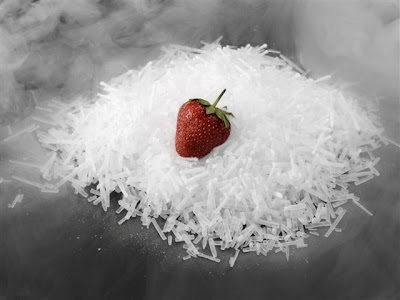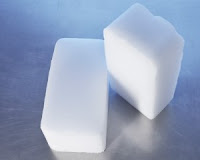
What is Dry Ice?
The manufacturing process of Dry Ice involves two steps. First, pure CO2 is expanded to a reduced pressure in a hydraulic press. The CO2 "snow" that is produced in this expansion is then compressed into blocks of Dry Ice. These blocks weigh approximately 52 lbs. each and measure 10"x10"x11".When CO2 is in its solid state, Dry Ice, it must be kept at -109 degrees. When Dry Ice is exposed to air, it converts (sublimates) back to its natural state, a gas.
Dry ice is
- non-toxic
- inflammable
- odourless and tasteless
- bacteriostatic – creates an inert atmosphere
Dry Ice Uses?
The most common use of dry ice is to preserve food.It is frequently used to package items that need to remain cold or frozen, such as ice cream or biological samples.
When dry ice is placed in water sublimation is accelerated, and low-sinking, dense clouds of smoke-like fog are created. This is used in fog machines, attheaters, discothèques, haunted house attractions, and nightclubs for dramatic effects. Unlike most artificial fog machines, in which fog rises like smoke, fog from dry ice hovers above the ground. Dry ice is useful in theater productions that require dense fog effects.
Dry ice can be used as bait to trap mosquitoes, bedbugs, and other insects, due to their attraction to carbon dioxide.
Dry ice blasting used for cleaning
Dry ice can be used for loosening asphalt floor tiles making it easy to pry off.
One of the largest mechanical uses of dry ice is blast cleaning. Dry ice pellets are shot out of a nozzle with compressed air. This can remove residues from industrial equipment. Examples of materials being removed include ink, glue, oil, paint, mold and rubber.
Dry ice can also be used seasonally for special effects. To make a foggy punch bowl that’s perfect for Halloween, you will need a large bowl for the dry ice, a smaller bowl for the punch, hot water, and dry ice. Throughout the entire process, do not let the dry ice come in contact with either bare skin or the punch. Using gloves, place a few handfuls of dry ice pellets into the larger bowl and fill it half way with hot water. Add your punch to the smaller of the two bowls, making sure that the punch does not come in direct contact with the dry ice. Float the smaller bowl filled with punch in the larger bowl containing the dry ice/hot water mixture. To maintain the fog effect, periodically add more dry ice and hot water to the bottom bowl. For an extra Halloween kick, use a cauldron as the outer large bowl. Float the smaller punch bowl inside the cauldron. Remember, always wear gloves when handling dry ice!
Dry Ice comes in different forms:
- Solid Blocks
- Cut-Blocks
- Nuggets (Pellets)
- Rice Nuggets (Pellets)
How long does Dry Ice last?
Dry Ice should be used as soon as bought or kept in a well insulated cooler. Dry Ice will "sublimate" at a rate of approximately 10 pounds every 24 hours. A 52 pound block is sufficient to keep food frozen, in a cooler, for about 6-7 days. You will need to purchase Dry Ice as close to when you plan to use it as possible, as Dry Ice will not keep. Dry Ice starts "sublimating" as soon as it's manufactured.How do you use Dry Ice?
For keeping material frozen, place the Dry Ice in the cooler on top of the frozen material (as cold goes down). Close the lid and do not open until necessary to minimize loss. Dry Ice will not harm frozen food.
Dry ice should never be handled with your bare hands!! Always wear gloves when using dry ice!
I was lucky enough to find dry ice for sale in pellet form - if you are able, try to get pellets instead of a block of dry ice.


I wanted to be able to quickly add multiple pellets of dry ice to my water bottle to avoid handling them too much or wasting smoke.
Taking a small sheet of tissue paper, I placed a few pellets in a straight line that was roughly the length of the bottle. I rolled them up in the tissue and twisted the ends, making dry ice "cigars". When I wanted to create the smoke effect, I just dropped two or three of these dry ice packs into the bottle. The water quickly dissolved the paper and mixed with the dry ice almost instantly.
I put all of the dry ice rolls into a thermal lunch bag, which kept them cool, and wore it over my shoulder inside the costume.
Where to buy Dry Ice:
Making dry ice
Solid carbon dioxide is known as dry ice. It sublimes at –78°C becoming an extremely cold gas. It is often used in theatres or nightclubs to produce clouds (looking a bit like smoke). Because it is denser than the air, it stays low. It cools the air and causes water vapour in the air to condense into tiny droplets – hence the clouds.It is also useful in the physics (and chemistry) laboratory.
The Institute of Physics has kindly produced this video to explain how dry ice is formed.
Safety
Dry ice can be dangerous if it is not handled properly. Wear eye protection and gauntlet-style leather gloves when making or handling solid carbon dioxide.Uses
Dry ice has many uses. As well as simply watching it sublime, you could also use it for cloud chambers, dry ice pucks, and cooling thermistors and metal wire resistors in resistance experiments. It can also be used in experiments related to the gas laws.Obtaining dry ice
There are two main methods of getting dry ice.1 Using a cylinder of carbon dioxide
It is possible to make the solid 'snow' by expansion before the lesson begins and to store it in a wide-necked Thermos flask.Remember that the first production of solid carbon dioxide from the cylinder may not produce very much, because the cylinder and its attachments have to cool down.
What type of cylinder, where do I get CO2, and what will it cost?
A CO2 gas cylinder should be fitted with a dip tube (this is also called a ‘siphon type’ cylinder). This enables you to extract from the cylinder bottom so that you get CO2 in its liquid form, not the vapour.NOTE: A plain black finish to the cylinder indicates that it will supply vapour from above the liquid. A cylinder with two white stripes, diametrically opposite, indicates it has a siphon tube and is suitable for making dry ice.
A cylinder from British Oxygen will cost about £80 per year for cylinder hire and about £40 each time you need to get it filled up. (The refill charge can be reduced by having your chemistry department cylinders filled up at the same time.)
Don't be tempted to get a small cylinder - it will run out too quickly.
If the school has its own CO2 cylinder there will be no hire charge, but you will need to have it checked from time to time (along with fire extinguisher checks). Your local fire station or their suppliers may prove a good source for refills.
CLEAPSS leaflet PS45 Refilling CO2 cylinders provides a list of suppliers of CO2.
A dry ice attachment for the cylinder
Dry ice disks can be made using an attachment that fits directly on to a carbon dioxide cylinder with a siphon tube. Section 13.3.1 of the CLEAPSS Laboratory Handbook explains the use of this attachment (sometimes called Snowpacks or Jetfreezers). This form is most useful for continuous cloud chambers and low-friction pucks.You can buy a Snowpack dry ice maker from Scientific and Chemical. Type ‘dry ice’ into the 'Search For' box, and enter 'Science Education' in the 'in' box. The product number is GFT070010.
2 Buying blocks or pellets
Blocks of solid carbon dioxide or granulated versions of it can be obtained fairly easily with a search on the Internet. Local stage supply shops or Universities may be able to help. It usually comes in expanded foam packing; you can keep it in this packing in a deep freeze for a few days.The dry ice pellets come in quite large batches. However, they have a number of uses in science lessons so it is worth trying to co-ordinate the activities of different teachers to make best use of your bulk purchase.
Finally take a look video about dry ice





.jpg)




0 коментарі:
¿Te animas a decir algo?